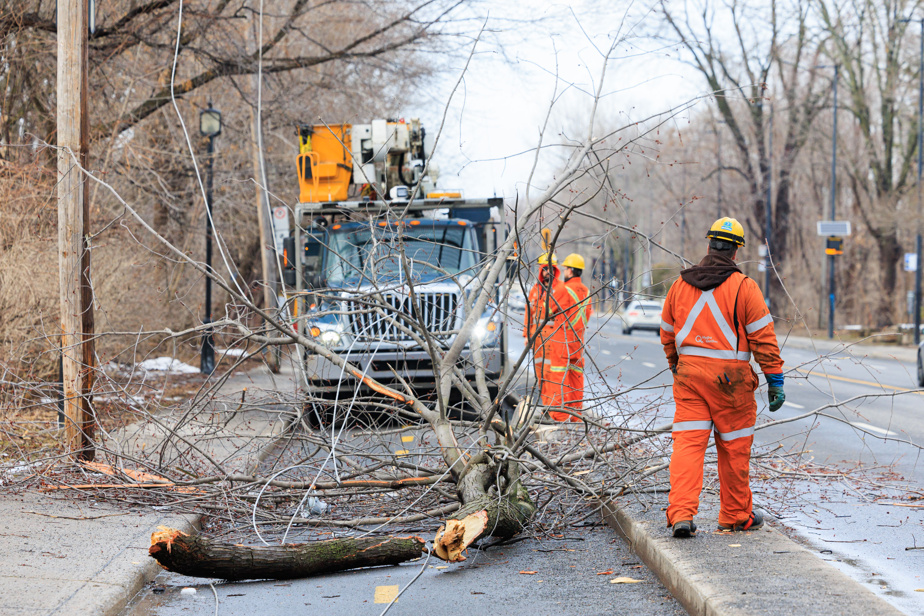Between 70% and 80% of Quebecers who are in the dark should be reconnected by the end of Friday evening, assures Hydro-Quebec. To achieve this, the state corporation first intends to reconnect the most sensitive sectors. However, the task is colossal: more than 1,100 employees will be deployed at all times.
“We are deploying all we can in financial, human and technical resources to connect you as quickly as possible. […] It’s not because it’s hot that we’re going slower, and it’s not because it’s Easter that we won’t give our 100%, “assured the outgoing CEO of Hydro on Thursday. -Quebec, Sophie Brochu, at a press briefing at the company’s head office.
At that time, more than one million Quebec homes lacked power. The good news, according to Hydro-Québec’s vice-president of maintenance operations, Régis Tellier, is that about a quarter of outages affect more than a thousand people.
Result: interventions can be targeted, and much more effective, according to him. Already on Thursday, the situation seemed to be “stabilizing”, the number of new customers who declared a lack of power having stopped increasing due to more favorable weather conditions than the day before. Priority is given to citizens in danger, then to health facilities and communication equipment.
The regions most affected by the blackouts remain the Outaouais, where the ice storm arrived first, but also the Montérégie and Montreal. The Quebec metropolis accounts for approximately 50% of breakdowns.
“We estimate that around 70 to 80% of our affected customers will be reconnected by midnight Friday,” said Tellier, whose team aims to connect around 350,000 customers a day, Thursday and Friday. However, he wants to make a “clear distinction” with the 1998 ice storm, which was much more serious “in terms of damage”.

PHOTO HUGO-SÉBASTIEN AUBERT, THE PRESS
Régis Tellier, vice-president of maintenance operations at Hydro-Québec
We have some poles on the ground, especially in Mirabel, but overall, it is mainly branches that have touched the network.
Régis Tellier, vice-president of maintenance operations at Hydro-Québec
Environment Canada also warned those with “bad memories of 1998” that the current weather scenario was “very different.” In 1998, we saw three storms and 100 millimeters of freezing rain in six days. This year, we are talking more about a storm of 33 mm of freezing rain in one day, followed by a rapid thaw, recalled the organization.
Nevertheless, Sophie Brochu calls on the population to stay away from electric wires, but also to “move [les] vehicles” away from sidewalks when these are obstructed, if possible, to allow employees to make connections. Teams from New Brunswick and Ontario could also provide assistance to Hydro-Québec in the coming hours, if necessary.
Develop “resilience”
Last December, the Auditor General of Quebec, Guylaine Leclerc, noted in a report that Hydro-Quebec “is not adequately equipped to face the growing challenge of aging assets”. Consequence: the reliability of its electricity distribution service presents a “marked decline”, she noted.
We learned that breakdowns due to faulty equipment affected nearly 2 million customers in 2021. Since 2012, excluding major weather events, “the average duration of outages per customer supplied has increased by 63% and the number of outages has increased by 16%,” wrote M.me Leclerc.
For Sophie Brochu, it is urgent that Quebec initiate a “societal discussion” on the development of longer-term energy “resilience”. “In recent years, we have increased investments in the control of vegetation to avoid as much as possible that the branches come into contact with the network,” she said.

PHOTO HUGO-SÉBASTIEN AUBERT, THE PRESS
Sophie Brochu, outgoing CEO of Hydro-Québec
What we have just experienced is a major ice storm. And there isn’t a vegetation program that’s going to be able [de l’absorber].
Sophie Brochu, outgoing CEO of Hydro-Québec
Repeating that this kind of weather event “is likely to happen again more and more”, the outgoing CEO of Hydro-Québec reiterates that “society must acquire stronger resilience”. “All the money in the world cannot be made just from Hydro-Québec. There is a discussion to be had on how one builds a place, a city. It’s a social affair […] in front of what will be more and more difficult”, she hammered.
To increase resilience across the province, Premier François Legault, meanwhile, says work is underway to provide smaller municipalities with “checkpoints, so people can go take a shower” for long periods of time. such storms. His government, he says, is also “in the process of adding capacity” to production and staffing at Hydro-Quebec.
